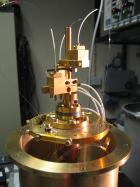Optoelectronics
The optoelectronics group is one of the most long established research activities in the University of Glasgow. We have been responsible for many breakthroughs in integrated optics and semiconductor laser devices, leading to many successful spinout activities. The group attracts diverse funding from government and industry sources and provides a superb training environment for researchers seeking a career in optoelectronics research and business.
The group benefits from the James Watt Nanofabrication Centre in the University of Glasgow, its own excellent test and measurement facilities, and a great many collaborations in the UK and overseas.
Research topics
Nonlinear optics
Photonic integration Quantum sensors Semiconductor lasers and LEDs
Staff
Quick Links
Nonlinear Optics
Professor David Hutchings, Professor Marc Sorel, Dr. Matteo Clerici
The Optical Frequency Conversion project addresses an emerging demand for low-cost, room-temperature, compact and flexible optical sources in the near- and mid-infrared part of the spectrum due to an increasing need for sensing applications, e.g. environmental, clinical analysis, pharmaceutical, security and forensics. We are working on technologies for difference frequency generation for WDM channel shifting and optical parametric generation of new near- and mid-IR wavelengths for sensing applications.
A key requirement for Photonic Quantum Technologies is a correlated photon source. We are applying our expertise to obtain integrable solutions for correlated photon sources at telecommunication wavelengths. We have also demonstrated monolithic integration compatibility with p-i-n diode laser pump sources in similar GaAs/AlGaAs superlattice waveguides. Using dichroic couplers, we have the basis for developing a fully-integrated correlated photon source on a III-V chip.
We are leading research in ultrafast third-order optical nonlinearities in semiconductor waveguides, such as nonlinear refraction (optical Kerr effect) and two-photon absorption. Using the AlGaAs waveguide platform we have demonstrated spectral broadening, all-optical switching, spatial solitons, vector (polarisation) solitons and discrete spatial solitons. More recently we have been studying the AlGaAs superlattice waveguides and using quantum-well intermixing to provide a spatial variation in the nonlinear coefficients.
Further information:
Photonic Integration
Professor David Hutchings, Professor Anthony Kelly, Professor John Marsh, Professor Marc Sorel
We work on a number of devices including optical isolators and related non-reciprocal devices such as circulators within standard optoelectronic wafer platforms, polarisation modulation controllers, atom trapping and quantum optical components.
All of our research is driven by the need for new components to be integrated into a broad range of systems. Current research themes are quantum information processing, telecommunications technologies, and sensors. Included in these activities are technologies for new wireless-optical interfaces, data encoding systems, wavelength division multiplexing, atomic clocks, and frequency standards.
Further information:
Quantum Sensors
The Quantum Sensors group specialises in Quantum Technologies for the most demanding sensing applications. Our sensing technologies span the energy range 100 eV – to 0.001 eV, placing X-ray detection, single-molecule detection, infrared single-photon detection and terahertz detection all within reach.
Applications for these technologies encompass single molecule detection, time-resolved photoluminescence detection, atmospheric remote sensing, fault testing in integrated circuits, astronomy, laser medicine, fibre temperature sensing and quantum information science.
Our core expertise is in superconducting materials and devices, but we are actively seeking new avenues for ultrasensitive detection. We draw upon the world class nanofabrication capability of the James Watt Nanofabrication Centre and aim to develop joint activities across the science and engineering research base at the University of Glasgow. Our links to industry are enhanced by the Scottish Sensor Systems Centre (CENSIS). Our international collaborations are boosted by the Scotland-Germany International Max Planck Partnership and the Scotland-Stanford SU2P Science Bridges Scheme.
Further information:

Semiconductor lasers and LEDs
Professor Marc Sorel, Professor Richard Hogg, Dr. David Childs, Professor John Marsh, Professor Anthony Kelly
Semiconductor ring and disk lasers (SRLs) have become an intense subject of research because of the rich variety of dynamics. We have exploited the all-optical bistability of SRLs to demonstrate all-optical flip-flop operation, optical logic gates (AND, OR and NOT), optical thresholders, signal regeneration and retiming, fast wavelength tunability and integrated master-slave configurations.
Further information:

